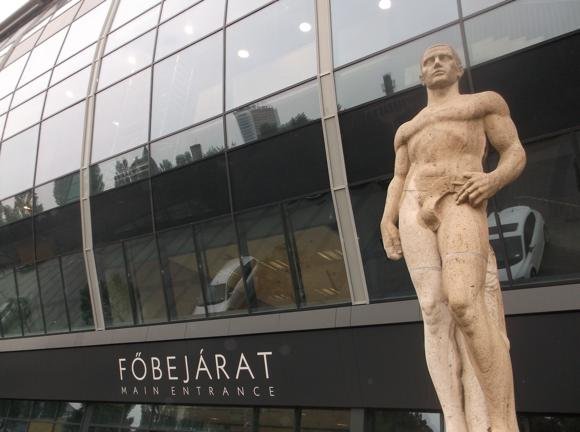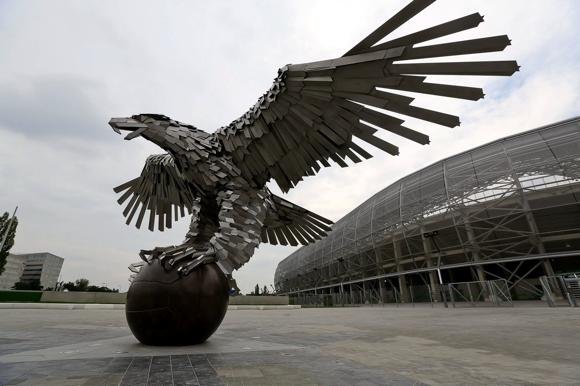This Sunday Chelsea visit Budapest for the prestigious opening of the Groupama Arena, new home of Ferencváros. Peterjon Cresswell takes in the new arena – and provides the background to its €40-million plus construction.
On Sunday, the most significant football stadium to be built in Hungary for 60 years officially opens its doors. With Chelsea the visitors for this curtain-raising, pre-season friendly, record title-winners Ferencváros stride out for the first time onto the pitch of the spanking new Groupama Arena.
Kicking off won’t be Eden Hazard, Didier Drogba or even Zoltán Gera, the former Fulham star recently returned to his alma mater after a decade in England – but Ferenc Rudas. Currently Hungary’s oldest international player, Rudas was a half-back in Fradi’s title-winning side of 1948-49 that also included Sándor Kocsis, Zoltán Czibor and László Budai, all in the Hungarian side that famously beat England 6-3 at Wembley in 1953.
Rudas is one of many historic personalities to be featured in the equally new FTC Múzeum (Tue-Fri noon-6pm, match days noon-3pm), to the left of the reception as you come in the main entrance. Look out for the line of lockers, each one with its own audio history as you open its door.
The museum, the skyboxes with doors tastefully decorated with further images from 115 years of FTC history, the stadium itself, with a podium at the home end (the notorious B-közép) for the song leader, all this was a million miles away this time eight years ago. Relegated for the first time in their 28-title history, Ferencváros spent the 2006-07 season in the lower flight – then 2007-08 and 2008-09.
Behind the scenes, eyeing the prime real estate on the main road that connects the airport with the Hungarian capital, British property tycoon Kevin McCabe had lined up the Hungarians to join his roster of clubs around the world, Sheffield United and China’s Chengdu Blades included.
McCabe bought the Budapest club, stadium, real estate, debts and all, for Ft3,035 billion – around €10 million in today’s money. It was estimated that the club’s debts amounted to more than half of that total – financial mismanagement the reason why Ferencváros were forcibly relegated in 2006.
Although the landmark deal went through in February 2008, FTC failed to make promotion that May. Or the following May.
Despite this, McCabe presented his ambitious blueprint for a new stadium complex. As well as a 21,000-seater multifunctional stadium, there would be a three- or four-star hotel, a shopping centre, a fitness centre, offices, restaurants and bars. The new football ground, to be named the Albert Arena after the famous FTC player from the 1960s, would have to be rotated 90 degrees so that the afternoon sun didn’t interfere with the goalkeeper’s vision, a directive from European football body UEFA.
Though promotion was achieved, McCabe’s project kept running against rows of red lights by the then Socialist government. When the right-wing Fidesz came to power in 2010, with football-mad Viktor Orbán as Prime Minister, a radical overhaul of Hungary’s major soccer stadiums was announced.
In 2011, McCabe relinquished ownership, which fell to the Hungarian State Holding Company, and Fidesz MP Gábor Kubatov was made club president.
The following April, Kubatov announced plans for a new Ferencváros stadium, of 22,600 capacity, with 29 skyboxes – and a pitch rotated at 90 degrees.
‘We travelled to a lot of key arenas around Europe for the latest ideas,’ said stadium design director Tamas Szekeres, overseeing the project. ‘The main new features include two floors of skyboxes, a VIP area, a bar/restaurant, a club museum and a cost-effective security system. We also went to Amsterdam to see how the smartcard system works instead of cash payments at all stadium outlets.’ Members can buy match tickets with their smartcards. Also revolutionary was the stadium WiFi that will allow users to see replayed action on their smartphones, a facility so far adopted hardly anywhere else in Europe.
À propos, after the worst period in the club’s history on the pitch, Ferencvaros began challenging for a European place. Dutch trainer Ricardo Moniz, a former skills coach at Tottenham, led a high-scoring side whose African and black Brazilian players found favour with the notoriously right-wing ‘Fradi’ following. Moniz helped promote a national anti-racist campaign in the Hungarian sports press.
‘We will be trying to encourage families back to the stadium,’ Szekeres outlined. As well as a family-friendly sector, the Ferencvaros stadium will be adaptable at the home end, which may accommodate standing spectators for domestic league matches, increasing capacity to nearly 24,000 from the set figure of 22,700 when all-seated. Away fans will be segregated by using a separate metro station to everyone else – again similar to methods used at many Dutch stadiums.
Construction began in 2013. Anyone driving past the building site that year – en route for an early flight out of Budapest, for example – may have seen the glare of workmen soldering metal almost round the clock.
Finished in double-quick time, quick enough to see Moniz replaced by former Hamburg SV star Thomas Doll, the Groupama Arena saw its first action for a Ferencváros-Újpest old boys’ 80-minute test match in front of a few thousand on August 4.
On the pitch was Flórián Albert, son of the namesake 1960s legend whose statue now stands outside the main entrance. Hungary’s last winner of the Ballon d’Or may have lost the prestige of having the new stadium named in his honour – but esteem is the kind of thing an insurance company cannot buy.
Ferencváros-Chelsea, Sun Aug 10, 7pm, Groupama Arena. M3 Népliget.







